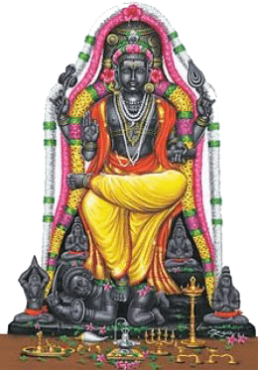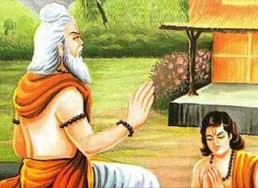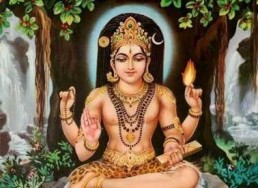Guru Paduka Stotram
वैराग्यसाम्राज्यदपूजनाभ्यां नमो नमः श्रीगुरुपादुकाभ्याम् ॥ 1 ॥
vairāgyasāmrājyadapūjanābhyāṃ namo namaḥ śrīgurupādukābhyām ॥ 1 ॥
Which is a boat, which helps me,cross the endless ocean of life,
Which endows me, with the sense of devotion to my Guru,
And by worship of which, I attain the dominion of renunciation.
दूरिकृतानम्र विपत्ततिभ्यां नमो नमः श्रीगुरुपादुकाभ्याम् ॥ 2 ॥
dūrikṛtānamra vipattatibhyāṃ namo namaḥ śrīgurupādukābhyām ॥ 2 ॥
Which is the ocean of knowledge, resembling the full moon,
Which is the water, which puts out the fire of misfortunes,
And which removes distresses of those who prostrate before it.
मूकाश्र्च वाचस्पतितां हि ताभ्यां नमो नमः श्रीगुरुपादुकाभ्याम् ॥ 3 ॥
mūkāśrca vācaspatitāṃ hi tābhyāṃ namo namaḥ śrīgurupādukābhyām ॥ 3 ॥
Which make those who prostrate before it,
Possessors of great wealth, even if they are very poor,
And which makes even dumb people in to great orators.
नमज्जनाभीष्टततिप्रदाभ्यां नमो नमः श्रीगुरुपादुकाभ्याम् ॥ 4 ॥
namajjanābhīṣṭatatipradābhyāṃ namo namaḥ śrīgurupādukābhyām ॥ 4 ॥
Which attracts us, to lotus like feet of our Guru,
Which cures us, of the unwanted desires,
And which helps fulfill the desires of those who salute.
नृपत्वदाभ्यां नतलोकपङ्कते: नमो नमः श्रीगुरुपादुकाभ्याम् ॥ 5 ॥
nṛpatvadābhyāṃ natalokapaṅkate: namo namaḥ śrīgurupādukābhyām ॥ 5 ॥
Which shine like gems on the crown of a king,
Which shine like a maid in the crocodile infested stream,
And which make the devotees attain the status of a king.
जाड्याब्धि संशोषण वाडवाभ्यां नमो नमः श्रीगुरुपादुकाभ्याम् ॥ 6 ॥
jāḍyābdhi saṃśoṣaṇa vāḍavābhyāṃ namo namaḥ śrīgurupādukābhyām ॥ 6 ॥
Which is like a series of Suns, driving away the dark sins,
Which is like the king of eagles, driving away the cobra of miseries,
And which is like a terrific fire drying away the ocean of ignorance.
रमाधवान्ध्रिस्थिरभक्तिदाभ्यां नमो नमः श्रीगुरुपादुकाभ्याम् ॥ 7 ॥
ramādhavāndhristhirabhaktidābhyāṃ namo namaḥ śrīgurupādukābhyām ॥ 7 ॥
Which endows us, with the glorious six qualities like sham,
Which gives the students ,the ability to go in to eternal trance,
And which helps to get perennial devotion to the feet of Vishnu.
स्वान्ताच्छभावप्रदपूजनाभ्यां नमो नमः श्रीगुरुपादुकाभ्याम् ॥ 8 ॥
svāntācchabhāvapradapūjanābhyāṃ namo namaḥ śrīgurupādukābhyām ॥ 8 ॥
Which bestows all desires of the serving disciples,
Who are ever involved in carrying the burden of service
And which helps the aspirants to the state of realization.
बोधप्रदाभ्यां दृतमोक्षदाभ्यां नमो नमः श्रीगुरुपादुकाभ्याम् ॥ 9 ॥
bodhapradābhyāṃ dṛtamokṣadābhyāṃ namo namaḥ śrīgurupādukābhyām ॥ 9 ॥
Which is the Garuda, which drives away the serpent of passion,
Which provides one, with the treasure of wisdom and renunciation,
Which blesses one, with enlightened knowledge,
And blesses the aspirant with speedy salvation.

Description

Reason 1: Padukas & Self-Knowledge
One Paduka represents the Truth or Self-Knowledge in which the Master is established, which lies dormant in our hearts and to which we have to awaken. The other Paduka is the symbol of awakening other people. Just as a lit candle, lights up other candles, the Master too has realized the Truth and His life is spent in awakening others.
When we worship the Padukas, we worship the Supreme Truth or Self-Knowledge. This Truth is in our own hearts as Consciousness, which is the All-Pervasive, Omnipotent, Omnipresent, Omniscient Reality, which we also call Ishwara. Even though we are yet to realize the Truth, by worshipping the Padukas we pray that we may wake up and awaken others.
The great Swami Chinmayananda explained the significance of the pada-puja/paduka puja as follows:
“Just as a Shiva Linga represents Shiva and Shaligrama represents Vishnu, in the same way, the feet of the Teacher represent to the students, not the feet, but the underlying concept. What we are invoking is Brahman, the Lord. But we cannot go directly to Him. We want a symbol. At this time, there is no symbol more sacred than the feet/Padukas of the teacher.”
Reason 2: Padukas & Humility
Another question that may strike us is How can I realize this Truth? What is required to know it? Self-Knowledge is the direct means to Know the Truth. To attain Self-Knowledge, Humility is required. In the 13th chapter of the Geeta, Bhagawan says – Amaanitvam Adambhitvam Ahimsa Kshantihi Aarjavam – Amaanitvam means humility. Worship of the Paduka represents humility. When we touch the feet of the elders or the Guru, or when we worship the Padukas, we bow down the highest part of our body (head) towards the lowest part (feet). The head is the symbol of ego and so, by worshipping the Padukas, we surrender. When a person becomes humble the person becomes very open, is ready to receive knowledge, does not have pre-conceived notions, is not arrogant about money, power, pleasure, body, beauty, fame; none of these. Such a person comes to know the Truth, is ready to do what it takes to know the Truth. In this way, the Padukas show the goal as well as the path, which is through humility.
There was once a king who wanted to know the Truth. He went to his Master and said “Can you please guide me to the Truth?” The Master, who lived on the outskirts of the kingdom, said “You have to live here, and since I don’t have accommodation in my cottage, you will have to live in the pigsty outside.”
The king said “Pigsty? Not possible. I can’t stay there.” He went back. He ruled the kingdom for a few more years. However, he felt very uncomfortable and disillusioned that there was no real happiness in the world and went back to the Master. The Master said, “I had told you that you will have to stay in the pigsty. If you are ready then we can start right this moment.” The king said, “I really want to know the Truth but that is a little too much. If you permit me, I will build one more cottage next to yours and I will stay there” The master replied “It is not possible.” So, again the king went back and ruled for another few years. The third time when he came, he didn’t go to the Master. He went straight to the pigsty. The Master went there and said; “Now you are ready. Come, stay with me. The idea was not that you had to stay there, but whether you were willing to do what it takes to know the Truth.”
When we worship the Padukas every day, we surrender the ego. Every time we say Namaha, Namaha, Namaha with each name of the Satguru, we surrender because namaha means na mama or not mine.
Reason 3: Padukas & Gratitude
The third lesson taught by the Padukas is gratitude. When a puja is done, it is an expression of gratitude. We are grateful to the Lord that we have so many blessings in our lives. When gratitude comes into our life, our life becomes more fulfilled. Without gratitude, even if we have everything, life still looks empty and we keep complaining, cribbing and victimizing ourselves. With gratitude, even if we have nothing there is completeness.
It is commonly thought that prayer is only a means to ask for something. A teacher asked a child “Did you pray today?” The child replied, “I didn’t want anything today so I didn’t pray.” Another teacher asked a student “Do you pray before food?” The student replied “No, my mother is a very good cook!”
Although one may attain things through prayers, it is primarily an expression of gratitude. This is especially true when we do the Guru Paduka Puja. In Vivekachudamani, Shankaracharyaji says that three things are a sure sign that the Grace of the Lord is with us:
1. Human birth – Manushyatvam
2. A burning desire to know the Truth – Mumukshutvam.
3. The Refuge under a Wise One – Maha-Purusha Samshrayaha
The very fact that a Satguru has come into our lives is a sign of the Grace of the Lord in our lives, as is the fact that we are able to study, understand and share that knowledge with others. When we do the puja, we express that gratitude.
It is the Uncaused and Infinite Compassion of the Satgurus, which makes them leave the quiet moments of Nirvikalpa Samadhi, a life of seclusion and solitude and come down to live amidst us and guide us to the Truth patiently. No matter what we do for such masters it is always less because everyone in the world makes a finite into a better finite entity. Eg. A poor man gets money, sick one becomes healthy, ignorant gets knowledge etc. But their sense of finitude does not go. It is only the Satguru who transforms the finite into Infinite through the initiation into Self-Knowledge. What can we offer such a master who ends the hunger of many lives and saves us from the cycle of birth and death? Gratitude and service born out of it, is the least that we can offer.
In the Kathopanishad and the Geeta, it is said Ascharyavad pashyati kaschidenam – it is a wonder if somebody comes to know this Truth. Self-Knowledge and everything associated with it – the student, the teacher, the teaching, the methodology, the consistent seeking & Self-Discovery, sharing the knowledge; each aspect is a wonder. So, to express that gratitude, a puja is done to say, “We are blessed with this Self knowledge which is a rare and divine blessing.” Very few people have that blessing. It is not that others do not deserve it, but the time has not yet come for them to absorb that in their life. In Vedanta it is said that their punya karma has to fructify, and then this happens.
Reason 4: Padukas and Hard Hittings
Fourth, the Padukas represent the hard hittings of the master. It is only at the feet of the master that we are made to realize (through various situations created by him) that “I am nothing.” Our pride/ego begins to take a hit and with continued Seva at the feet of the Guru in a spirt of total surrender, it dissolves over time. The master delivers this with love and understanding, but it also hits hard. A saint said it very well:
Satguru mera suramaa, kare shabd ki chot.
Maare gola prem kaa, hare bharam ki khot.
My Satguru is an expert in hitting (the ego) with words. He does it with love and destroys delusion.
As Adi Sankaracharya says in Bhaja Govindam, to the old man who even in his last few moments was memorizing the rules of sanskrit grammar – Bhaja Govindam, Bhaja Govindam, Govindam Bhaja Mudha Mate- Oh deluded fool! Even when the master calls him a deluded fool, it is out of compassion and not to insult or to belittle the student. It is to actually shake him and wake him up from the slumber, through words. The basis is love.
There is a quote: “The teacher does not look at our ability or inability, he wants our availability.” If available, even the dullest student realizes the Absolute Truth and if somebody is not available, even though the person maybe very bright, nothing happens. In Vedanta there is a lot of knowledge that we have, and lot of people think that Vedanta is only intellectual, dry, subtle and boring. We often think that Vedanta is separate from bhakti. Actually, Bhakti is the most important component of Vedanta. If there is no Guru Bhakti, no transformation can happen through Vedanta. Adi Shankaracharya would say, it is “like a donkey carrying golden bricks.” All the informative knowledge is like the golden bricks. It will only add more weight instead of reducing the ego. So the fourth point is that it is the symbol of the hard hitting of the master and one’s readiness to accept it.
Reason 5: Padukas – Protection, Destruction, Realisation
Last one is the etymological meaning of the word Paduka.
‘Pa’ means to protect. The grace of the Guru always protects the disciple, whether the disciple knows and acknowledges it or not. The moment one comes under the umbrella of a Satguru, of a Master who has known the Truth, the grace of that Master always protects. For a spiritual student, Grace is very important because there are lots of weaknesses that we have, which we cannot overcome by our effort. We may try very hard – anger, lust, jealousy, passion, insecurity, the very sense of identification with the body – all these are very difficult to overcome. Merely by self-effort it is not possible. Grace is necessary to overcome these. The more the student invokes the Grace, the more that Grace protects the student. Not just the student, but also his family, the people around, the whole environment gets purified. Not only do the Padukas protect, but the Guru-Padukas promise that they will establish the seeker in the Kingdom of Dispassion and Detachment.
Du means Dunoti, it burns away. When the worship of the Padukas is done regularly in my sadhana, it helps to burn away my negative tendencies slowly and steadily because the devotion that grows in one’s heart will burn away all the negatives and limitations. In the fire of Self-Knowledge, all my ignorance is burnt away and karmas of many lives also get destroyed. Srimad Bhagavad Geeta says in the 4th Chapter – “The fire of knowledge burns away all one’s karmas, just as a small spark is enough to burn away huge stacks of hay.”
Kaa means Kaashate – to shine. A person shines in one’s own true glory when all the negativities are gone. The Self within reveals itself and one gets established in one’s true nature. The Gurupaduka Stotram says that the padukas establish a person in the state of Samadhi – the Self.
Negativities are divided into three –
1. Mala (kama, krodha, lobha, moha, mad, matsarya) –anger, greed, lust, passion, delusion and intoxication,
2. Vikshepa or Wanderings of the mind
3. Avidya – Ignorance – not knowing the Self/Truth.
These three impurities, when burnt, a person shines in one’s own true glory.
Blessed are we that we were found by a Satguru and taken under His wings. Many lives of Punya must have fructified for this to happen. We pray that may our devotion to His Lotus Feet ever increase in our hearts and lead us to the ‘Chinmaya’ within.
In summary, these are few aspects about Padukas and when we do the Paduka Puja we invoke all these.
1. It is the goal, which we have to discover as humans.
2. It is the means, that is, humility.
3. Helps us to invoke and express Gratitude
4. Hard hittings of the master to blast our ego.
5. The word meaning – to protect, to burn and to shine.
By Swami Swatmananda
Additional Links
Guru Paduka Stotram – Significance and Commentary by Swami Paramarthananda can be viewed here
A book on Sri Guru Paduka Stotram by Swami Tejomayananda.
The Guru can grant us everything – from the most mundane to the highest. His glories are infinite and his position, especially for a spiritual seeker, is supreme. Then what to speak of the glory of his padukas that serve him always, and which represent all that he stands for – Truth, God, knowledge, divinity and virtues. Shri Guru Paduka Stotram is a hymn that enumerates 25 glories of the padukas of the Guru. Swami Tejomayananda, with words soaked in devotion of his own Guru and the entire lineage of Gurus, expounds on these glories in a thought-provoking and heart touching way. Reading, reflecting and revelling in this hymn will surely bring all that is promised.
https://eshop.chinmayamission.com/product/shri-guru-paduka-stotram
Other Guru Shlokams
Guru Ashtakam
The Guru Ashtakam is a Sanskrit hymn composed by Adi Shankaracharya, the 8th-century Indian philosopher and saint who consolidated the doctrine of Advaita Vedanta. In the Vedan
Guru Brahma
Guru Brahma - Known as Guru Mantra or Guru Mahamantra. The guru is Brahma (Bramha) the guru is Vishnu, the guru is Maheshwara (Siva), the guru is the Self-revealing limitless Brahman. Salutations to that revered guru. - In Sanskrit with English…
Guru Sishya Parampara
Guru-Sishya Parampara is the teacher-disciple lineage. Being a civilization that respects experiential knowledge, we hold high respect for the teacher of such knowledge. Below
Guru Stotram
Guru stotram is a selection of 14 verses from the Guru Geeta, found in Skanda Purana. It is a conversation between Lord Shiva & Parvati on the glory of the Guru. Gu – Darkness. Ru – Remover.
Ishvaro Guru Atmeti
Shlokams,Shiva,Dakshinamurthy,Guru,Sankara
Salutations to Lord Dakshinamurti, who is all-pervasive like space but who appears (as though) divided as Lord, Guru, and the Self.
Sada Shiva Samarambam
Salutation to the lineage starting with lord Sadasiva, with Adi Sankara in the middle and continuing up to my immediate teacher.
Samasta Jana Kalyane
I salute, Shri Chinmaya, the noble teacher, the best of the knowers of Brahman (the highest Reality), and who full of compassion, is ever engaged in the welfare of all people.
Guru Paduka Stotram – Guru – With English Transliteration, Translation and Meaning. Commentary for selected Shlokams.


